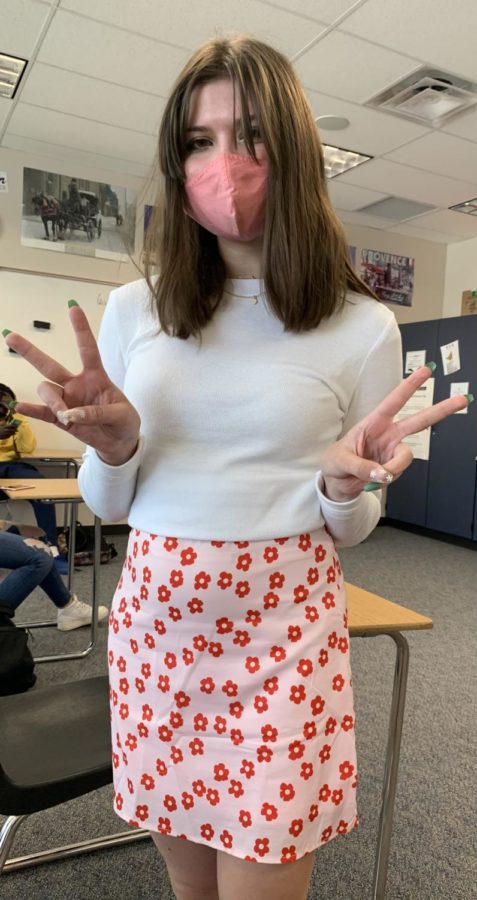The Ethicality of Fast Fashion
One of the most notable of the quick and easy shops is Shein, a Chinese E-Commerce company that has recently been dominating the industry. “I weirdly enjoy going to the mailbox to check if a package has arrived and I feel like with online there are often more coupons and promo codes,” said Ariel Benze (11). For certain shoppers, the choice to shop at these sellers is dependent on more than just the money.
Culture and society are ever-evolving; technology to treatments, politics to personal life, everything around humanity is continually growing and changing. Long-standing principles like capitalism have flourished in America, with commercial supply and demand perpetually fluctuating. Ignoring more complicated matters like the stock market, teenagers today have found solace in a century-long tradition: shopping. Nothing beats the rush of serotonin chemicals from the instant gratification of exchanging hard-earned cash for something a person’s been eyeing for months. But now, the basic principle of purchasing items for practical use has evolved once more. Other companies have followed suit with their own online shopping experiences, with sites like Amazon dominating the world. This transition from in-person to online has its ups and downs, but this kind of growth happens and benefits both the buyer and the supplier.
Shein, Yesstyle, Aliexpress, and more fast fashion brands have grown to become a staple of many teens’ wardrobes. While more reliable and foundational stores exist, many shoppers, both young and old, find efficiency in their low prices and endless options. Browsing through thousands of clothing articles brings the same kind of browsing mindset as endlessly scrolling through social media, but with the bonus of possibly purchasing a new bag or skirt for less than ten dollars, ignoring the ethical quality of these suppliers. But what else draws the eyes of consumers? What else makes shoppers fill their cart to the fullest?
A big pull for most shoppers is, of course, the price, the most critical factor for anything a person could buy in most cases. Sites like Shein and even long-standing brands like Forever 21 harbor endless customers’ keys through astonishing price tags. Cherokee Trail student Taylor May (11) does her best to shop sustainably but has also plunged into the pit of convenience once before.
“Honestly, I used to shop a lot at places like H&M and Target just because the clothes were cheap, but the quality was so off that I’ve stopped,” said May.
At times though, these low-cost pieces of clothing are all that is available. Not everyone can purchase high-quality, sustainably made, expensive outfits. Considering that every person has their finances, Kaili Kreutzer (11) remarks on how this can influence how people shop.
“I shop fast fashion brands like Shein because it’s affordable and trendy and mostly because I don’t have enough money for nicer clothes that are more sustainable and not fast fashion,” said Kreutzer.
But at what cost do these clothes come at environmentally? Not all skirts and dresses are made equally, and with such bargain deals, it begs the question of how these companies get their inventory so inexpensive? Unfortunately, the answer can revolve around some unsavory practices, but brands like Shein have denied any claims on how they mistreat workers. Still, it’s ultimately up to the shopper to decide how to spend their money, as Ariel Benze (11) goes into detail.
“That’s just the price of capitalism. That’s how it is for Apple, Target, Walmart, Forever 21, etc. There’s no good way to make ethical and environmental decisions unless you want to spend a hundred dollars on a pair of jeans. Of course, this is important to conserve the environment and make things ethically, but it’s unfortunately unrealistic to buy everything at higher prices,” said Benze.
So what are the options for those who strive to sustain the planet while still keeping in mind a reasonable budget? Many people choose to purchase their clothes from second-hand sellers or thrift stores; this option allows for less waste and fair pricing.
“It helps the environment and gives old clothes a better use rather than being thrown away. It also typically costs very little and can be easier to buy for people with less money,” said Kreutzer.
Fast fashion is a towering force in the world of clothing. The struggle between low price but considerable harm and high price but intense damage is endless for those who strive to aid the environment without hurting their wallet. Alternatives like thrift shops and online sellers offer another path for purchasing unique and expressive outfits for affordable prices, shining some light on the dark industry of sweatshops and rivers filled with waste. The ever-evolving world of consumerism will continue to push these products as long as people will buy them, even if the costs are detrimental to the planet; it is up to the buyers to have the responsibility to act consciously of the world around them.











Maddilynn Gude • Apr 12, 2021 at 10:30 am
I really like the topic of the story and how it’s organized. I also really enjoy how you added alternative stores like Shein that had clothes for cheaper and other peoples opinions. Great job CToday!
Sydney Wiersma • Apr 12, 2021 at 10:19 am
This is an important issue for teens to consider that needs more attention, so this is a great article. It balanced the importance of maintaining ethical purchasing habits, the struggle with finance, and the right to choose very well.